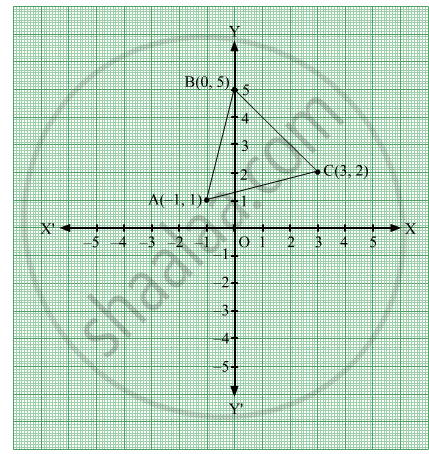Advertisements
Advertisements
प्रश्न
Find the area of the triangle whose vertices are (-1, 1), (0, 5) and (3, 2), using integration.
उत्तर

Let A (-1,1), B (0,5) and C (3,2)
The equation of line AB is
y -1 = `(5 -1)/(0+ 1) ("x"+1)`
y = `4"x" + 5`
The equation of line BC is
y - 5 = `(2 -5)/(3 -0) ("x" -0)`
y = `-"x"+5`
The equation of line CA is
y - 2 = `(1 -2)/(-1 -3) ("x" -3)`
y = `("x")/(4) + (5)/(4)`
Required area = Area of ΔABC
The equation of line CA is
y - 2 = `(1 -2)/(-1 -3) ("x" -3)`
y = `("x")/(4) + (5)/(4)`
Required area = Area of ΔABC
= `int_-1^0 (4x + 5) dx + int_0^3 (- x + 5) dx - int_-1^3 ( x/4 + 5/4) dx`
= `[ 2x^2 + 5x ]_-1^0 + [ -x^2/2 + 5x ]_0^3 - [ x^2/8 + 5x/4 ]_-1^3`
= `3 + 21/2 - 39/8 - 9/8`
= `15/2` sq. units
APPEARS IN
संबंधित प्रश्न
Find the integrals of the function:
sin 3x cos 4x
Find the integrals of the function:
cos 2x cos 4x cos 6x
Find the integrals of the function:
sin3 (2x + 1)
Find the integrals of the function:
sin3 x cos3 x
Find the integrals of the function:
sin 4x sin 8x
Find the integrals of the function:
cos4 2x
Find the integrals of the function:
`1/(sin xcos^3 x)`
Find the integrals of the function:
`(cos 2x)/(cos x + sin x)^2`
Find the integrals of the function:
`1/(cos(x - a) cos(x - b))`
`int (sin^2x - cos^2 x)/(sin^2 x cos^2 x) dx` is equal to ______.
`int (e^x(1 +x))/cos^2(e^x x) dx` equals ______.
Find `int dx/(x^2 + 4x + 8)`
Evaluate `int_0^(3/2) |x sin pix|dx`
Find `int((3 sin x - 2) cos x)/(13 - cos^2 x- 7 sin x) dx`
Find `int_ (sin "x" - cos "x" )/sqrt(1 + sin 2"x") d"x", 0 < "x" < π / 2 `
Find:
`int"dx"/sqrt(5-4"x" - 2"x"^2)`
Find: `int sec^2 x /sqrt(tan^2 x+4) dx.`
Find: `int sin^-1 (2x) dx.`
Find `int "dx"/(2sin^2x + 5cos^2x)`
Find `int x^2tan^-1x"d"x`
`int "e"^x (cosx - sinx)"d"x` is equal to ______.
Evaluate the following:
`int tan^2x sec^4 x"d"x`
Evaluate the following:
`int (cosx - cos2x)/(1 - cosx) "d"x`
`int (x + sinx)/(1 + cosx) "d"x` is equal to ______.
`int sinx/(3 + 4cos^2x) "d"x` = ______.
The value of the integral `int_(1/3)^1 (x - x^3)^(1/3)/x^4 dx` is
